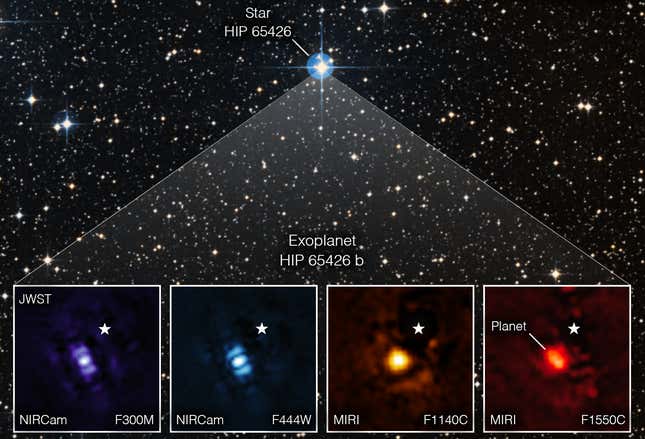
There it is, in four different bands of the infrared spectrum: the gas giant HIP 65426b, the first exoplanet directly imaged by the Webb Space Telescope.
“Obtaining this image felt like digging for space treasure,” said Aarynn Carter, an astronomer at the University of California, Santa Cruz, who led the analysis of the images, in a NASA release. “At first all I could see was light from the star, but with careful image processing I was able to remove that light and uncover the planet.”
While these are its first direct images of an exoplanet, Webb did collect spectra of an exoplanet earlier this summer. That spectra—of another gas giant, WASP 96b—revealed water vapor in the planet’s atmosphere and was released in July alongside Webb’s first scientific images of the cosmos.
HIP 65426b could only be seen by Webb once the telescope’s coronagraphs blocked out light from the planet’s host star, the location of which is marked in the above image with a small white star icon. The bars on the planet’s sides are artifacts of Webb’s imaging process, rather than objects in space. (The same can be said for the six-pointed diffraction spikes that appear in some of the telescope’s images.)
The planet is more than 10,000 times fainter than its host star and about 100 times farther from it than Earth is from the Sun (~93 million miles), so it easily could be spotted when the telescope’s coronagraphs removed the starlight. The exoplanet is between six and 12 times the mass of Jupiter—a range that could be narrowed once the data in these images is analyzed. The planet is only 15 million to 20 million years old, making it very young compared to our 4.5-billion-year-old Earth.
“I think what’s most exciting is that we’ve only just begun,” Carter said. “There are many more images of exoplanets to come that will shape our overall understanding of their physics, chemistry, and formation. We may even discover previously unknown planets, too.”
Exoplanets are distant and very faint compared to other cosmic objects like stars. They’re much harder to get well-resolved images of than large structures like galaxies, which Webb has already done with flourish.
The recent image of the gas giant is a portent of what’s to come for Webb, whose science will focus on the earliest light we can see and the evolution of galaxies and stars, but also the diverse array of exoplanets in the cosmos. You can keep up with what Webb is observing at any moment using a convenient Twitter bot. It makes you feel that much closer to the forthcoming insights.
More: Webb Telescope Just Detected Carbon Dioxide in a Distant World